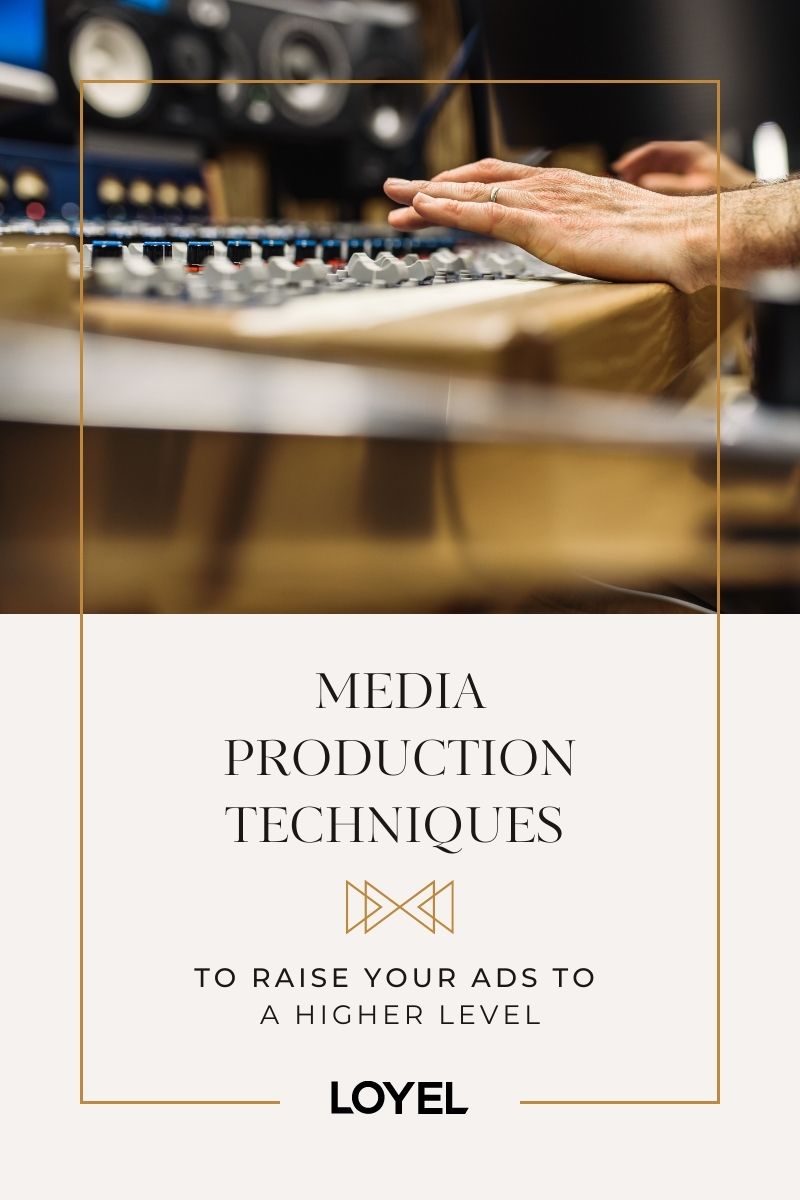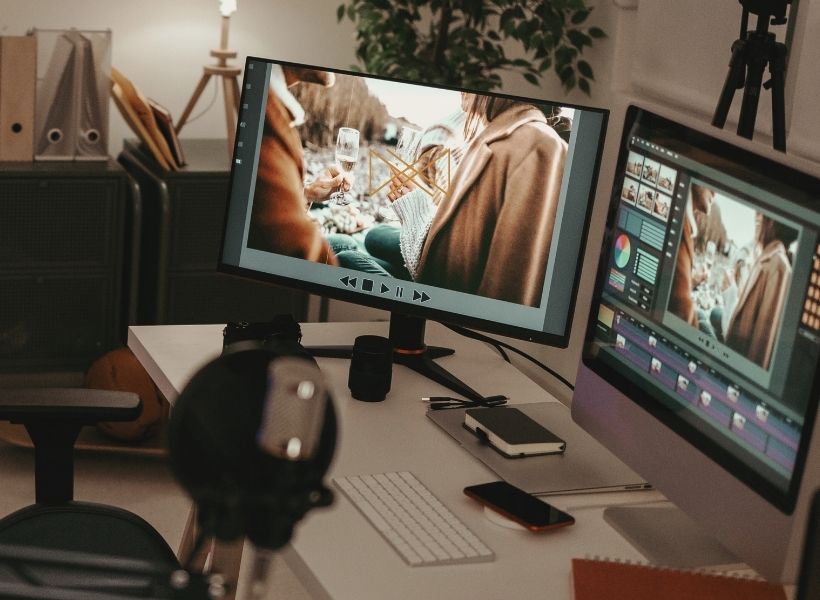In its final stages, producers use a range of media production techniques to push your advertising project to the next level.
Ads that stand out and are polished and persuasive—increase the odds your customer takes action.
And you wouldn’t hinge your campaign’s success on run-of-the-mill ads that fall flat.
A bang-up producer is equipped with the professional tools and expertise to apply digital enhancements with creative precision.
So while it may not take magic to produce great ads, it does take skill.

Like woodworking—producing ads is a work in progress. It starts with a few carefully selected unfinished pieces.
In media production, these include:
- Footage
- Images
- Audio
- Voiceovers
- Sound effects
- Music
And much like a carpenter follows a blueprint, an editor uses a script to guide them as they assemble the pieces they’ll use for your project into a working session.
To start, they get rid of any unnecessary parts, edit out noise and mistakes, arrange the elements they’re keeping, and balance volume and exposure levels.
By resolving these issues beforehand, the creative work that follows can move ahead smoothly and without the risk of being compromised.
Media Production Techniques in Advertising
Audio and video editors use a mix of software-based effects in post-production—from color grading to sound design—to make ads punchy, dynamic, and, ultimately, more powerful. Your producer will choose the ones that best serve your project.
Here’s a rundown of some of the media production techniques they might use to enhance your ad and achieve the best result. We’ll break them into two categories: visual and audio.
Visual Techniques
Video producers apply visual effects, for example, speed ramps and animation, to specific parts of your footage to increase engagement, create drama, and keep the story moving.
Take a look at how and why they use these techniques and the end result:
- Color correction produces more natural and uniform tones by fixing problems in your footage, like color balance and exposure, before color grading.
- Color grading creates a specific mood or style by manipulating color and contrast in your footage and images to pull your viewer in and make your ad more compelling.
- Compositing merges images and/or video clips to create a new piece of content. It’s commonly used to add video effects, such as fire or lightning, to a scene. Compositing is also used when your videographer captures footage against a green screen. Then, in post-production, a new background is produced, and the green is swapped out.
- Ken Burns effect pans and zooms over still images to add motion and movement.
- Lower third uses on-brand text and graphics often placed in the lower area of the screen to give your viewer more information, for example, the name and title of the speaker on screen.
- Motion graphics combine animation with graphic design using logos, icons, illustrations, and type to make your video easier to follow and understand. It’s a great way to show how a product works, demonstrate a concept or idea, present statistical data, or tell a story.
- Sound bridge uses sound to transition from one scene to another. Music, narration, or a sound effect continue as the next scene appears. Along the same line, an audio bridge can be used when producing audiobooks, podcasts, and audio drama series to foreshadow what lies ahead or make an episode more suspenseful.
- Speed ramping adds an edginess to your video by slowing down or speeding up sections of your footage. You’ll often see it used in sports videos, action movies, and corporate advertising to grab attention, add drama, or build suspense.

Audio Techniques
Audio effects make your ad credible and moving, establishing an emotional connection with your audience. Producers apply these effects to music, sound effects, and voiceovers to evoke a particular feeling and get a specific response.
- Sound design involves creating and manipulating audio elements to make an advertisement more convincing. Such as recording and mixing ambient noise, music, Foley effects, and dialogue, as well as adding special effects to create a realistic and immersive audio experience. This enhances the emotional impact of the project and creates a more engaging experience for your audience.
- Sound mixing makes your ad sound polished by adjusting the audio levels of these same elements. This ensures a cohesive and more even-keeled final audio track.
- Compression balances audio that’s all over the road—taming spikes and dips in your project. Producers use it to reduce the volume of loud sounds and increase the volume of quiet sounds.
- Equalization helps fix imperfections in your audio. Say, dialogue that sounds shrill, muffled, and hard to understand, or distracting background noises or boomy sounds. EQ essentially adjusts the frequency balance of your audio tracks so they all work well together and sound great.
- Modulation gives sound depth—making it fuller, dreamier, or surreal. Producers use modulation effects such as chorus, flanging, and pitch shifting to convey emotions, add drama, and create a range of voices. Here’s what we mean:
- Chorus can make a section of audio larger than life so that it stands out in the mix. It’s commonly used in sports promos, concert commercials, and broadcast station IDs. Chorus makes a phrase, sound, or section of music sound bigger and thicker by digitally duplicating it.
- Flanging, on the other hand, is a time-delay effect that’s often used to convey intangible concepts like motion or energy. Think about a spontaneous stadium wave during a packed sporting event as it sweeps across the arena and how that might sound and feel. Flanging can also simulate an indefinable sound like flying through the air, being underwater, or weightless in space. This technique can add a dreamlike, mysterious, or quirky quality to a sound effect or piece of music.
- Pitch shifting changes the original pitch of a sound, which can convey different emotions such as surprise, delight, sadness, or anger through variations in tone of voice. Producers use this technique to auto-tune a singer’s performance or give a voice a unique quality. For example, they can slow down and stretch a voice’s vibrations to create a villain’s deep and gravelly voice like Darth Vader or Bane, or speed up and squeeze a voice’s vibrations to produce a high-pitched character-ish voice like an elf, gnome, or South Park character.
- Spatial effects are time-based studio effects producers use to reproduce a natural echo—but for different reasons.
- Reverb imitates the sound of different spaces, like a classroom or concert hall. It can digitally replicate any environment called for in a script. To give you an idea, say a narrator needs to sound like they’re speaking to a large audience in a crowded stadium. A producer uses reverb to create the effect of sound waves bouncing off surfaces and give the impression of a specific three-dimensional space.
- Delay replicates an echo by repeating a sound. It’s like shouting “hello” into a canyon and hearing it bounce back to you. The sound is duplicated and played back at set intervals to create this effect.

Producers use various tools in the studio to apply these media production techniques that impact our emotions and behavior and leave a lasting impression.
These tools include:
- Non-linear editors (NLE) such as AVID, Final Cut Pro, and Adobe Premiere are examples of professional video-editing software.
- Digital audio workstations (DAW) such as Pro Tools, Cubase, Logic, or Nuendo are typical audio engineering tools.
- Skilled animators use varying software and tools to bring their ideas to life, such as Adobe After Effects, Maya, and Cinema 4D.
- Audio and video enhancement plugins provide more ways to add advanced effects to your project
Media production techniques are the key to any successful audio or video advertising project, whether it’s radio, TV, streaming, or digital ads.
Bear in mind less is generally better than more when using them.
Overuse a particular effect, and the results can be overpowering—like adding too much salt to a recipe.
And some effects, if mixed correctly, work well together. But combining the wrong ones—like spices that don’t pair well—can ruin the whole dish.
Expert producers have the creative and technical skills to use these techniques with great effect to create impressive ads that not only last, but also give you a competitive edge.
Comments +